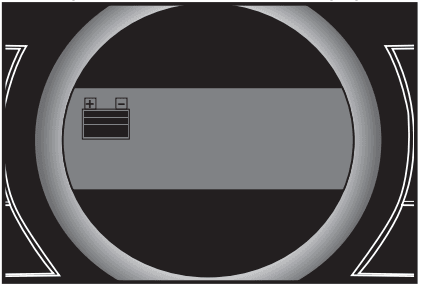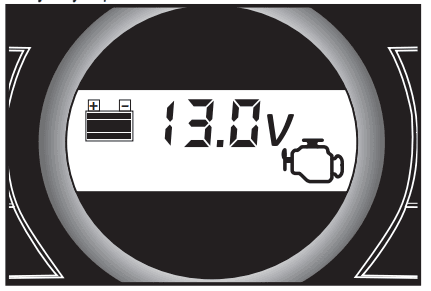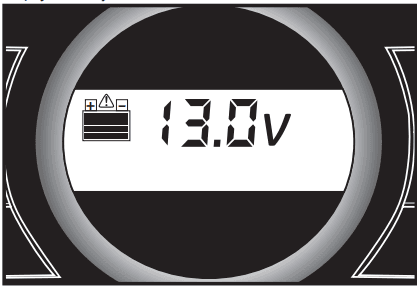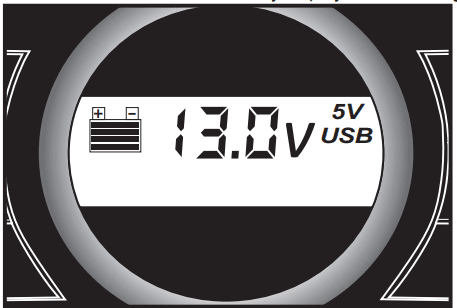
Stanley FatMax PPRH7DS Multipurpose Professional Power Station
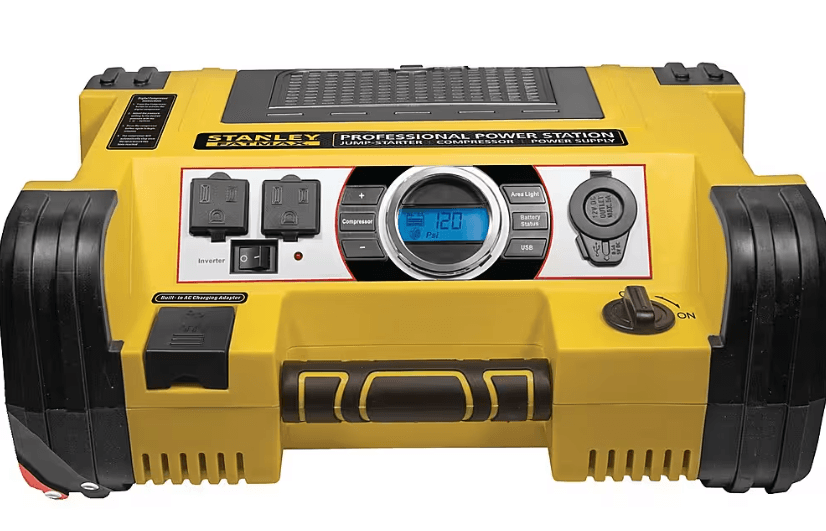
FEATURES
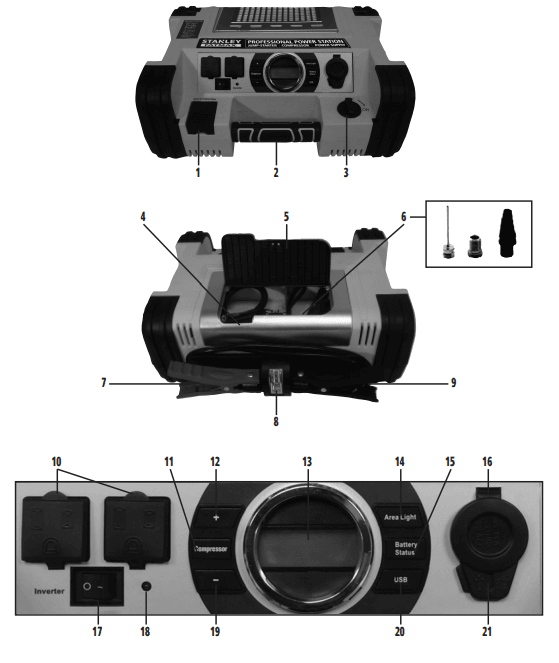
- Built-in 120-volt AC charger (under protective cover)
- Rubber grip handle
- Jump-starter power switch
- Air hose and SureFit® nozzle connector
- Storage compartment cover
- Nozzle adapters
- Positive (+) red clamp
- LED area light
- Negative (–) black clamp
- Dual 120 volt AC outlets (under protective covers)
- Compressor power button
- Compressor pressure control button (+)
- LCD screen
- The area light power button
- Battery status button
- 12-volt DC accessory outlet (under protective cover)
- Inverter power switch
- Inverter power indicator
- Compressor pressure control button (–)
- USB power button
- USB charging port (under protective cover)
DIGITAL LCD SCREEN
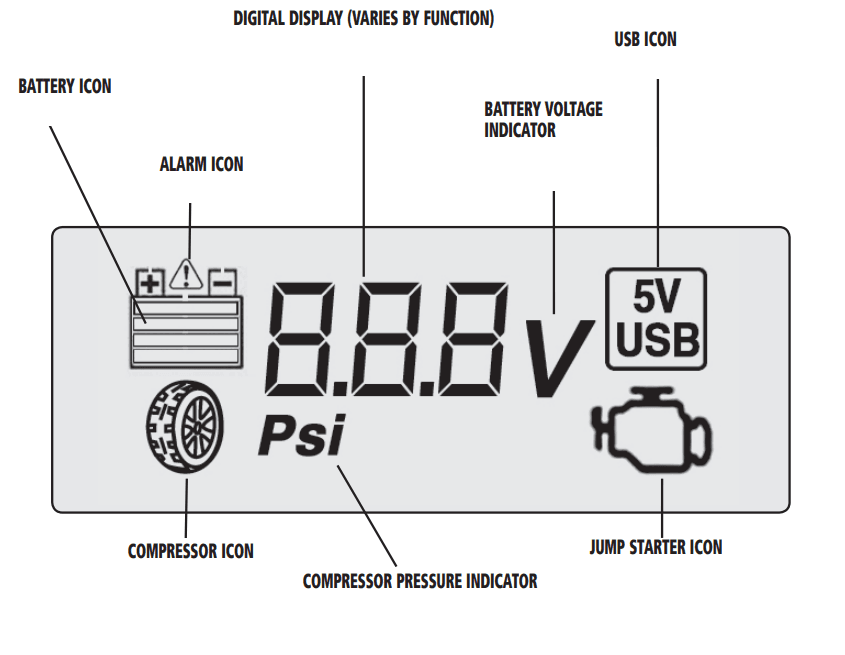
SAFETY GUIDELINES / DEFINITIONS
DANGER: Indicates an imminently hazardous situation that, if not avoided, will result in death or serious injury.
WARNING: Indicates a potentially hazardous situation which, if not avoided, could result in death or serious injury.
CAUTION: Indicates a potentially hazardous situation which, if not avoided, may result in minor or moderate injury.
CAUTION: Used without the safety alert symbol indicates potentially hazardous situations which, if not avoided, may result in property damage.
RISK OF UNSAFE OPERATION. When using tools or equipment, basic safety precautions should always be followed to reduce the risk of personal injury. Improper operation, maintenance,e or modification of tools or equipment could result in serious injury and property damage. There are certain applications for which tools and equipment are designed. The manufacturer strongly recommends that this product NOT be modified and/or used for any application other than for which it was designed. Read and understand all warnings and operating instructions before using any tool or equipment.
IMPORTANT SAFETY INSTRUCTIONS
READ ALL INSTRUCTIONS
WARNING: Read all instructions before operating power station. Failure to follow all instructions listed below may result in electric shock, fire and/ or serious injury.
GENERAL SAFETY WARNINGS AND INSTRUCTIONS
WARNING: This product or its power cord contains lead, a chemical known to the State of California to cause cancer and birth defect or other reproductive harm.
Wash hands after handling.
- This unit was designed for household use only.
WARNING – RISK OF FIRE, ELECTRIC SHOCK, BURST HAZARD, OR INJURY TO PERSONS OR PROPERTY
- void dangerous environments. Don’t use appliances in damp or wet locations. Don’t use appliances in the rain.
- Keep children away. All visitors should be kept at a distance from the work area.
- Dress properly. Do not wear loose clothing or jewelry. They can be caught in moving parts. Rubber gloves and substantial, non-skid footwear are recommended when working outdoors. Wear a protective hair covering to contain long hair.
- Store idle appliances indoors. When not in use, appliances should be stored indoors in dry, and high or locked-up places – out of reach of children.
- Don’t abuse the cord. Never carry the appliance by cord or yank it to disconnect from the receptacle. Keep cord from heat, oil, and sharp edges.
- Disconnect appliances. Disconnect the appliance from the power supply when not in use, before servicing, and when changing accessories.
- Ground Fault Circuit Interrupter (GFCI) protection should be provided on the circuits or outlets to be used. Receptacles are available having built-in GFCI protection and may be used for this measure of safety.
- Use of accessories and attachments. The use of any accessory or attachment not recommended for use with this appliance could be hazardous. Refer to the accessory section of this manual for further details.
- Stay alert. Use common sense. Do not operate this equipment when you are tired or impaired.
- Check for damaged parts. Any part that is damaged should be replaced by the manufacturer before further use. Do not use the tool if the switch does not turn it on and off. Contact the manufacturer at (877) 571-2391 for more information.
- Do not operate this appliance near flammable liquids or in gaseous or explosive atmospheres. Motors in these tools normally spark, and the sparks might ignite fumes.
- Never submerge this unit in water; do not expose it to rain, or snow or use when wet.
- To reduce the risk of electric shock, disconnect the unit from any power source before attempting maintenance or cleaning. Turning off controls without disconnecting will not reduce this risk.
- This equipment employs parts (switches, relays, etc.) that produce arcs or sparks. Therefore, if used in a garage or enclosed area, the unit MUST be placed not less than 18 inches above the floor.
- Do not use this unit to operate appliances that need more than 5 amps to operate from the 12-volt DC accessory outlet.
- Do not insert foreign objects into the USB port, the 12-volt DC accessory outlet, or the 120-volt AC outlet.
SPECIFIC SAFETY INSTRUCTIONS FOR CHARGING THIS UNIT
IMPORTANT: This unit is delivered in a partially charged state. Fully charge the unit with a household extension cord for a full 40 hours before using it for the first time.
You cannot overcharge the unit using the AC charging method.
- To recharge this unit, use only the built-in AC charger.
- All Power switches should be in the OFF position when the unit is charging or not in use. Make sure all switches are in the OFF position before connection to a power source or load.
EXTENSION CORDS:
WARNING: Use of improper extension cord could result in a risk of fire and electric shock. When using an extension cord, make sure that the pins of the extension cord are the same number, size, and shape as those in the charger; and be sure to use one heavy enough to carry the current your product will draw. An undersized cord will cause a drop in line voltage resulting in loss of power and overheating. The following table shows the correct size to use depending on cord length and nameplate ampere rating. If in doubt, use the next heavier gauge. The smaller the gauge number, the heavier the cord.
When an extension cord is used, make sure that:
- the pins of the extension cord are the same number, size, and shape as those in the charger,
- the extension cord is properly wired and in good electrical condition,
- the wire size is large enough for the AC rating of the charger.
CAUTION – TO REDUCE THE RISK OF INJURY OR PROPERTY DAMAGE: Pull the extension cord by the plug rather than the cord when disconnecting from the built-in 120-volt AC charger or the AC outlet.
SPECIFIC SAFETY INSTRUCTIONS FOR JUMP STARTERS
WARNING: BURST HAZARD
Do not use the unit for charging dry-cell batteries that are commonly used with home appliances. These batteries may burst and cause injury to persons and damage property. Use the unit for charging/boosting a lead-acid battery only. It is not intended to supply power to a low-voltage electrical system other than in a starter-motor application.
- Use of an attachment not supplied, recommended, or sold by the manufacturer specifically for use with this unit may result in a risk of electrical shock and injury to persons.
WARNING: RISK OF EXPLOSIVE GASES
- Working in the vicinity of a lead-acid battery is dangerous. Batteries generate explosive gases during normal battery operation. For this reason, it is of the utmost importance that each time before using the jump-starter you read this manual and follow instructions exactly.
- To reduce the risk of battery explosion, follow these instructions and those published by the battery manufacturer and manufacturer of any equipment you intend to use in the vicinity of the battery. Review cautionary markings on these products and on the engine.
CAUTION – TO REDUCE THE RISK OF INJURY OR PROPERTY DAMAGE:
- NEVER ATTEMPT TO JUMP-START OR CHARGE A FROZEN BATTERY.
- Vehicles that have on-board computerized systems may be damaged if the vehicle battery is jump-started. Before jump-starting, read the vehicle’s owner’s manual to confirm that external-starting assistance is suitable.
- Never smoke or allow a spark or flame in the vicinity of the vehicle battery, engine or power station
- Stay clear of fan blades, belts, pulleys, and other parts that can cause injury to persons.
- Remove personal metal items such as rings, bracelets, necklaces and watches when working with a lead acid battery. A lead acid battery can produce a short circuit current high enough to weld a ring, or similar metal object, to skin, causing a severe burn.
- Do not wear vinyl clothing when jump-starting a vehicle. Friction can cause dangerous static electrical sparks.
- Be extra careful to avoid dropping a metal tool onto the battery. It might spark or short-circuit the battery or another electrical part and could cause an explosion.
- Jump-start procedures should only be performed in a safe, dry, well-ventilated area.
- Always store battery clamps when not in use. Never touch battery clamps together. This can cause dangerous sparks, power arcing, and/or explosions.
- When using this unit close to the vehicle’s battery and engine, stand the unit on a flat, stable surface, and be sure to keep all clamps, cords, clothing, and body parts away from moving vehicle parts.
- Never allow red and black clamps to touch each other or another common metal conductor — this could cause damage to the unit and/or create a sparking/ explosion hazard.
- For negative-grounded systems, connect the positive (red) clamp to the positive ungrounded battery post and the negative (black) clamp to the vehicle chassis or engine block away from the battery. Do not connect the clamp to the carburetor, fuel lines, or sheet-metal body parts. Connect to a heavy gauge metal part of the frame or engine block.
- For positive-grounded systems, connect the negative (black) clamp to the negative ungrounded battery post and the positive (red) clamp to the vehicle chassis or engine block away from the battery. Do not connect the clamp to the carburetor, fuel lines, or sheet-metal body parts. Connect to a heavy gauge metal part of the frame or engine block.
- If the clamps are connected incorrectly with regard to polarity, the backlit LCD screen will display the empty battery icon. The “+” and”–” signs and the Alarm Icon above the empty battery icon will flash and the unit will sound a continuous alarm until the clamps are disconnected. Disconnect the clamps and reconnect to the battery with the correct polarity.
- Always disconnect the negative (black) jumper cable first, followed by the positive (red) jumper cable, except for positive grounded systems.
- Do not expose the battery to fire or intense heat since it may explode. Before disposing of the battery, protect exposed terminals with heavy-duty electrical tape to prevent shorting (shorting can result in injury or fire).
- Place this unit as far away from the battery as cables permit.
- Never allow battery acid to come in contact with this unit.
- Do not operate this unit in a closed area or restrict ventilation in any way.
- This system is designed to be used only on vehicles with a 12-volt DC battery system. Do not connect to a 6-volt or 24-volt battery system.
- This system is not designed to be used as a replacement for a vehicular battery. Do not attempt to operate a vehicle that does not have a battery installed.
- Excessive engine cranking can damage a vehicle’s starter motor. If the engine fails to start after the recommended number of attempts, discontinue jump-start procedures and look for other problems that may need to be corrected.
- Do not use this jump starter on a watercraft. It is not qualified for marine applications.
- Although this unit contains a non-spillable battery, it is recommended that the unit be kept upright during storage, use, and recharging. To avoid possible damage that may shorten the unit’s working life, protect it from direct sunlight, direct heat, and/or moisture.
SPECIFIC SAFETY INSTRUCTIONS FOR INVERTERS
WARNING – TO REDUCE THE RISK OF ELECTRIC SHOCK:
- Do not connect to AC distribution wiring.
- Do not make any electrical connections or disconnections in areas designated as IGNITION PROTECTED. This inverter is NOT approved for ignition-protected areas.
- Never immerse the unit in water or any other liquid, or use it when wet.
WARNING – TO REDUCE THE RISK OF FIRE:
- Do not operate near flammable materials, fumes, or gases.
- Do not be exposed to extreme heat or flames.
CAUTION – TO REDUCE THE RISK OF INJURY OR PROPERTY DAMAGE:
- Disconnect the appliance plug from the inverter outlet before attempting any repairs to the appliance.
- When an appliance plugged into this unit is used outdoors, use only extension cords intended for use outdoors and so marked.
- Do not attempt to connect the inverter while operating your vehicle. Not paying attention to the road may result in a serious accident.
- Always use the inverter where there is adequate ventilation.
- Always turn the inverter off when not in use.
- Keep in mind that this inverter will not operate high-wattage appliances or equipment that produce heat, such as hair dryers, microwave ovens, and toasters.
- Do not use this inverter with medical devices. It is not tested for medical applications.
- Operate the inverter only as described in this Instruction Manual.
SPECIFIC SAFETY INSTRUCTIONS FOR THE USB PORT
- Do not insert foreign objects into the USB Port.
- Do not attach USB hubs or more than one personal electronic device to the USB Port.
- Some household USB-powered electronics will not operate with this unit.
SPECIFIC SAFETY INSTRUCTIONS FOR COMPRESSORS
CAUTION – TO REDUCE THE RISK OF INJURY OR PROPERTY DAMAGE: Never leave the compressor unattended while in use.
WARNING – BURST HAZARD: BURSTING ARTICLES CAN CAUSE SERIOUS INJURY.
- Carefully follow instructions on articles to be inflated.
- Never exceed the recommended pressure listed in instructions on articles to be inflated. If no pressure is given, contact the article manufacturer before inflating.
- Monitor the pressure at all times on the pressure gauge.
CAUTION – TO REDUCE THE RISK OF PROPERTY DAMAGE:
- Do not operate the compressor continuously for longer than approximately 10 minutes, depending on ambient temperatures, as it may overheat.
FIRST AID
When working with lead acid batteries, always make sure immediate assistance is available in case of accident or emergency. Always have protective eyewear when using this product: contact with battery acid may cause blindness and/or severe burns. Be aware of first aid procedures in case of accidental contact with battery acid.
INTRODUCTION
Congratulations on purchasing your new Stanley® FatMax® Professional Digital Power Station. Read this Instruction Manual and follow the instructions carefully before using this unit.
OVERVIEW
Common Actions and Unit Responses
| Press the LED Area Light Power Button. | A beep will sound and the Area Light will turn on. The backlight will turn on for 10 seconds (only). The LCD screen will continue to display the battery status and voltage indicator. The LED Area Light remains on until switched off. |
| Press the Battery Status Button. | A beep will sound and the backlit LCD screen will display the battery status and voltage indicator for 10 seconds before the unit automatically turns off. |
| Press the USB Power Button. | A beep will sound and the backlit LCD screen will display the battery status and voltage indicator, as well as the USB icon, indicating the USB port is available. The unit remains on until the USB power button is pressed again to turn it off. |
| Press the Compressor Power Button. | A beep will sound and the backlit LCD screen will display the battery status and the Compressor Icon and will alternately show the flashing pre-set psi value (that was last set using the compressor pressure control buttons) and the current pressure of the item being inflated (which will light solid). If no further actions are taken after 1 minute, the unit will display the battery status and voltage indicator for 10 seconds before automatically turning off. |
| Whenever the clamps are properly connected to a battery or the Jump Starter Power Switch is rotated to the ON position … | … a one-second beep will sound every minute. The backlit LCD screen will display the battery status and voltage indicator, as well as the flashing Jump Starter Icon. The unit remains on until the Jump Starter Power Switch is switched back to the OFF position or the clamps are disconnected from the battery. |
| If the clamp connections to the battery’s positive and negative terminals are reversed … | … the backlit LCD screen will display the empty Battery Icon. The Alarm Icon and the “+” and ”–” signs above the Battery Icon will flash and the unit will sound continuously until the clamps are disconnected from the battery. |
| When the unit is charging or recharging using the built-in 120 Volt AC Charger … | … the backlight will turn on for 10 seconds (only). The LCD screen will continue to display the battery status. The bars on the battery icon will change from empty to solid (bottom to top) repeatedly. |
VIEWING BATTERY STATUS
To check the unit’s battery charge level, press the Battery Status Button. The Battery Icon will indicate the battery charge level as follows:
- If the battery charge level is at full capacity, four solid bars will display.
- If the battery is partially charged, two or three solid bars will be displayed.
- If the battery is nearly empty, one solid bar will display. The unit MUST be charged at this time or the unit’s built-in low voltage protection will activate. The empty battery icon and the backlight of the LCD screen will flash 10 times before automatically shutting down.
- If the Battery Icon displays four blank bars, the battery is completely empty. The unit will not operate until the battery is recharged.
CHARGING/RECHARGING
Lead-acid batteries require routine maintenance to ensure a full charge and long battery life. All batteries lose energy from self-discharge over time and more rapidly at higher temperatures. Therefore, batteries need periodic charging to replace energy lost through self-discharge. When the unit is not in frequent use, the manufacturer recommends the battery should be recharged at least every 30 days and after each use.
IMPORTANT: If you attempt to use the unit when the unit’s battery charge level is too low, the unit will automatically shut down. Recharge the unit with all other functions turned off as soon as possible.
Notes: This unit is delivered in a partially charged state – you must fully charge it before using it for the first time. The initial AC charge should be for 40 hours. Recharging the battery after each use will prolong battery life; frequent heavy discharges between recharges and/or overcharging will reduce battery life. Make sure all other unit functions are turned off during recharging, as this can slow the recharging process.
Charging/Recharging Using the Built-In 120 Volt AC Charger and AC Extension Cord (not included)
- Lift the protective cover of the built-in 120-volt AC charger located on the lower left front of the unit (refer to the Features section to locate). Connect an extension cord to the unit. Plug the other end of the cord into a standard 120‑volt AC wall outlet. When the unit is properly connected to an AC power source, the LCD screen will display the following (the screen will be backlit):
 The bars on the battery icon represent the capacity level of the unit’s internal battery. After 10 seconds, the backlight will shut off and the LCD screen will display the following to indicate that the unit is charging:
The bars on the battery icon represent the capacity level of the unit’s internal battery. After 10 seconds, the backlight will shut off and the LCD screen will display the following to indicate that the unit is charging:
- Charge for approximately 40 hours or until the battery icon shows 4 solid bars.
- When charging is complete, unplug the AC extension cord from the AC outlet and then disconnect it from the unit.
Note: The unit cannot be overcharged using this method. The unit will not charge if the inverter power switch is turned on.
JUMP-STARTER
This unit is equipped with a jump starter power switch that allows energy to flow only when proper connections are made to the battery and frame. Take the following steps, observing all cautions and warnings in the “Important Safety Instructions” section at the front of this manual.
- Turn off vehicle ignition and all accessories (radio, A/C, lights, connected cell phone chargers, etc.). Place the vehicle in “park” and set the emergency brake.
- Make sure the jump-starter power switch is in the off position.
- Remove jumper clamps from clamp tabs. Connect the red clamp first, then the black clamp.
- Procedure for jump-starting a NEGATIVE GROUNDED SYSTEM (negative battery terminal is connected to chassis) (MOST COMMON)
- Connect the positive (+) red clamp to the vehicle battery’s positive terminal.
- Connect negative (–) black clamp to the chassis or a solid, non-moving, metal vehicle component or body part. Never clamp directly to the negative battery terminal or moving part. Refer to the automobile owner’s manual.
- Procedure for jump-starting POSITIVE GROUND SYSTEMS
Note: In the rare event that the vehicle to be started has a Positive Grounded System (positive battery terminal is connected to chassis), replace steps 4a and 4b above with steps 5a and 5b, then proceed to step 6.- Connect the negative (–) black clamp to the vehicle battery’s negative terminal.
- Connect positive (+) red clamp to vehicle chassis or a solid, non-moving, metal vehicle component or body part. Never clamp directly to the positive battery terminal or moving part. Refer to the automobile owner’s manual.
- When the clamps are connected properly, the unit will automatically turn on in jump-starter mode. The backlit LCD screen will display the following to indicate the unit is ready to jump-start: The jump-start icon will flash to indicate the clamps are properly connected.

IMPORTANT: If the clamps are connected incorrectly with regard to polarity, the reverse polarity connection alarm will sound continuously and the backlit LCD screen will display the following (the “+” and”–” signs and the alarm icon above the empty battery icon flash):
- Turn the Jump-Starter Power Switch to ON.
- Turn ON the ignition and crank the engine in 5-6 second bursts until the engine starts.
- Turn the Jump-Starter Power Switch back to the OFF position.
- Disconnect the negative (–) engine or chassis clamp first, then disconnect the positive (+) battery clamp.
LED AREA LIGHT
The built-in 3-LED area light is controlled by the area light power button on the control panel (refer to the Features section to locate). Press the area light power button once to turn the light on. Press the area light power button again to turn the area light off.
IMPORTANT: When the area light power button is pressed to turn it on, a beep will sound. The backlit LCD screen will turn on for 10 seconds (only) and will then continuously display the battery status.
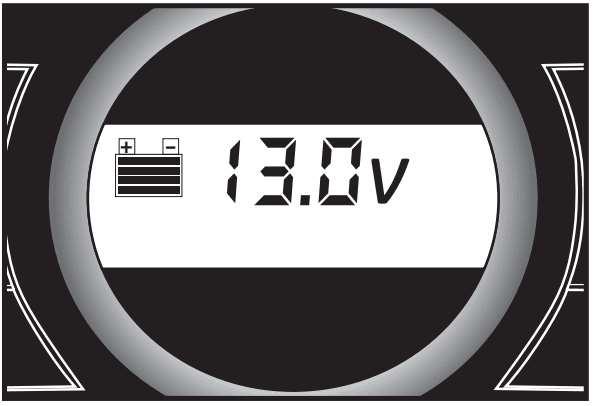
Periodically check the unit’s battery status on the LCD screen. Four solid bars in the battery icon indicate a full battery. When the battery level is nearly empty with only one solid bar, the unit MUST be recharged at this time or the unit’s built-in low voltage protection will activate. The unit will sound a beep 5 times, then the area light will automatically turn off. The unit will then display the battery status and voltage indicator for 10 seconds before automatic shutdown. Make sure the area light and the unit are turned off when the unit is being recharged or stored.
120 VOLT AC PORTABLE POWER SUPPLY
Rated Versus Actual Current Draw of Equipment
Most electrical tools, appliances, electronic devices, and audio/visual equipment have labels that indicate the power consumption in amps or watts. Be sure that the power consumption of the item to be operated is below 500 watts. If the power consumption is rated in amps AC, simply multiply by the AC volts (120) to determine the wattage.
Resistive loads are the easiest for this unit to run; however, it will not run larger resistive loads (such as electric stoves and heaters), which require far more wattage than the unit can deliver on a continuous basis. Inductive loads (such as TVs and stereos) require more current to operate than do resistive loads of the same wattage rating.
Power Inverter Output Waveform
The AC output waveform of this inverter is known as a modified sine wave. It is a stepped waveform that has characteristics similar to the sine wave shape of utility power. This type of waveform is suitable for most AC loads, including linear and switching power supplies used in electronic equipment, transformers, and small motors.
Using the Dual 120 Volt AC Outlets
The two 120-volt AC outlets each are located under a protective cover on the left-hand side of the front panel (refer to the Features section to locate). The two outlets support a combined maximum power draw of 500 watts.
- Press the inverter power switch to turn the inverter on (I). The inverter power indicator will light red to indicate the two 120-volt AC outlets are ready to use.
- Lift up the cover of the 120-volt AC outlet.
- Insert the 120-volt AC plug from the appliance into the 120-volt AC outlet.
- Switch on the appliance and operate it as usual.
Periodically check the unit’s battery status on the LCD screen by pressing the Battery Status Button. Four solid bars in the battery icon indicate a full battery. When the battery level is nearly empty with only one solid bar, the unit MUST be recharged at this time.
Make sure the inverter is turned off when the unit is being recharged or stored.
Protective Features
The inverter monitors the following conditions:
- Low internal battery voltage: The inverter will automatically shut down when the battery voltage drops too low, as this can harm the battery.
- High internal battery voltage: The inverter will automatically shut down when the battery voltage is too high, as this can harm the unit.
- Thermal shutdown protection: The inverter will automatically shut down when the unit becomes overheated.
- Overload/short circuit protection: The inverter will automatically shut down when an overload or short circuit occurs.
- Important Notes: The inverter power/status indicator will flash red to indicate that one of the above fault conditions is present before automatic shutdown occurs. Should this occur, take the following steps:
- Disconnect all appliances from the unit.
- Press the inverter power switch to turn the inverter off (O).
- Allow the unit to cool down for several minutes.
- Make sure the combined rating for all appliances plugged into the unit is 500 watts or lower and that appliance cord(s) and plug(s) are not damaged.
- Assure there is adequate ventilation around the unit before proceeding.
12 VOLT DC PORTABLE POWER SUPPLY
The 12-volt DC power supply is located under a protective cover on the front of the unit. Refer to the Features section to locate it. This portable power source is also for use with all 12-volt DC accessories equipped with a male accessory outlet plug and is rated up to 5 amps.
- Lift up the cover of the unit‘s 12-volt DC outlet.
- Insert the 12-volt DC plug from the appliance into the 12-volt accessory outlet on the unit. DO NOT EXCEED A 5 AMP LOAD.
- Switch on the appliance and operate it as usual.
- Periodically check the unit’s battery status on the LCD screen by pressing the Battery Status Button. (Four solid bars in the battery icon indicate a full battery. One bar indicates that the unit needs to be recharged.)
USB CHARGING PORT
The USB charging port is under the same protective cover as the 12-volt DC outlet. Refer to the Features section to locate it.
- Press the USB power button to turn the USB port on. A beep will sound and the backlit LCD screen will continuously display the following:

- The “5V USB” icon indicates that the USB port is ready to use.
- Plug the USB-powered device into the USB power port and operate normally.
The USB power port remains on until the USB Power button is pressed again to turn it off. Make sure the USB Power Button is in the off position when the unit is being recharged or stored. Periodically check the unit’s battery status on the LCD screen. Four solid bars in the battery icon indicate a full battery. When the battery level is nearly empty with only one solid bar, the unit MUST be recharged at this time or the unit’s built-in low voltage protection will activate. The unit will sound a beep 5 times, then the USB Charging Port will automatically turn off. The unit will then display the battery status and voltage indicator for 10 seconds before automatic shut down.
Note: This unit’s USB power port does not support data communication. It only provides 5V DC/1000mA power to an external USB-powered device.
PORTABLE COMPRESSOR
The built-in 12 volt DC compressor is the ultimate compressor for all vehicle tires, trailer tires and recreational inflatables. Three different-sized nozzle adapters are supplied. Each nozzle adaptor will screw onto the end of the SureFit® nozzle connector at the free end of the compressor hose. The compressor hose with tire fitting is stored in the compressor hose storage compartment. Refer to the
“Features” illustration for locations of compressor hose. The compressor power button and compressor pressure control buttons are located on the control panel on the front of the unit.
Before proceeding, check the unit’s battery status on the LCD screen. Four solid bars in the battery icon indicate a full battery. When the battery level is nearly empty with only one solid bar, the unit MUST be recharged before use.
The compressor may be used by removing the air hose from the storage hatch and if required, fitting an appropriate nozzle adapter to the air hose. The compressor is capable of inflating up to 120 pounds per square inch (psi) pressure. The compressor can operate long enough to fill up to 3 average-sized tires before the battery must be recharged. Return the hose to the storage compartment after use.
TROUBLESHOOTING
Unit will not charge
- Make sure the inverter power switch is in the off position.
- Make sure a suitable gage extension cord is properly connected to both the unit and a functioning AC outlet.
Unit fails to jump-start
- Make sure unit’s jump-starter power switch is in the on position.
- Make sure a proper polarity cable connection has been established.
- Check that unit has a full charge. Recharge unit if necessary.
120 volt AC outlet will not power appliance
- Make sure the inverter power switch is in the on position.
- Make sure you have followed all the steps in the 120 AC portable power supply instructions carefully.
- Make sure the appliance being powered does not draw more than 500 watts
- Refer to the important notes included in that section that explain common problems and solutions.
- Check that the unit has a full charge. Recharge the unit if necessary.
12 12-volt DC accessory outlet will not power the appliance
- Make sure the appliance does not draw more than 5 amps.
- Check that the unit has a full charge. Recharge the unit if necessary.
USB power port will not power the appliance
- Make sure the USB power button is in the on position.
- Some USB-powered household electronics will not operate with this USB charging/ power port. Check the manual of the corresponding electronic device to confirm that it can be used with this type of USB charging/power port.
- Check that the unit has a full charge. Recharge the unit if necessary.
LED area light does not come on
- Make sure the area light power button is in the on position
- Check that the unit has a full charge. Recharge the unit if necessary.
ACCESSORIES
Recommended accessories for use with your tool may be available from the manufacturer. If you need assistance
SPECIFICATIONS
- Boost Ampere: 12Vdc, 700A instant
- Battery type: Maintenance-free, sealed lead acid, 12Vdc, 19Ah
- AC input: 120Vac, 60Hz, 12W
- Area light: 3 white LEDs
- USB port: 5Vdc, 1,000mA
- DC accessory outlet: 12Vdc, 5A
- Dual 120V AC outlets: 120Vac, 60Hz, 500W continuous
- Compressor maximum pressure: 120 PSI
For more manuals by Stanley FatMax, visit MnaualsLibraryy
Stanley FatMax PPRH7DS Multipurpose Professional Power Station-FAQs
How long does it take to fully charge the Stanley FatMax?
It takes less than an hour to fully charge.
How do I operate the Stanley FatMax air compressor?
Lift the red ON/OFF switch on the pressure switch to turn it ON. Push the switch down to turn it OFF. Make sure to use the supplied air filter.
Why is the Stanley battery blinking red?
A blinking red light indicates the battery is either too hot or too cold. The LED alternates between fast and slow blinks to signal this.
Can the Stanley FatMax charge a car battery?
Yes, the Stanley FatMax can charge a 12V car battery.
How many amps are needed to jump-start a car?
For most consumer vehicles, 400 to 600 amps are sufficient. Commercial vehicles may require up to 1500 or 2000 amps, while small vehicles can be jump-started with 150 amps.
How long does the Stanley FatMax battery last?
The battery can power and recharge personal electronics for up to 10 hours, including laptops, tablets, cell phones, and more.
What is the difference between Stanley and Stanley FatMax?
Stanley FatMax is a sub-brand designed for professionals, offering heavy-duty, durable tools that can handle demanding applications.
When was the Stanley FatMax introduced?
The Stanley FatMax line was launched in 1999.
How do I charge the Stanley FatMax unit?
Open the AC cover near the handle, connect an extension cord to the built-in AC adapter, and plug the other end into a live 120V AC wall outlet.
How do I activate a Stanley vacuum bottle or jar?
Preheat or precool it by filling it with warm or cold tap water and letting it stand for five minutes. Empty the bottle, fill it with your beverage, and quickly secure the lid to minimize heat loss.
What is the duty cycle of the Stanley air compressor?
The Stanley 2.5HP 50L Belt Drive Air Compressor has a 95% duty cycle, making it ideal for long periods of continuous use in both trade and home applications.


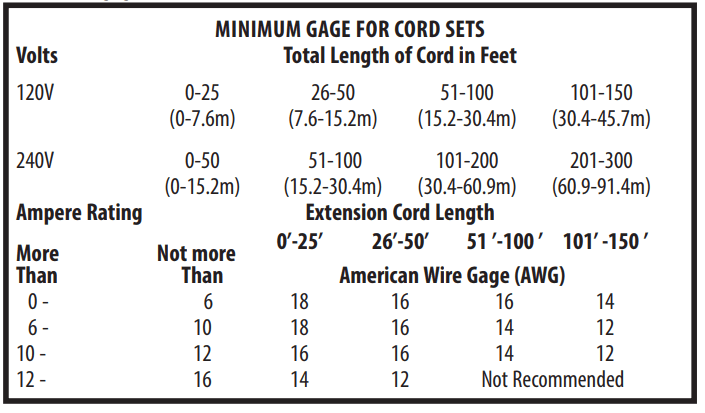
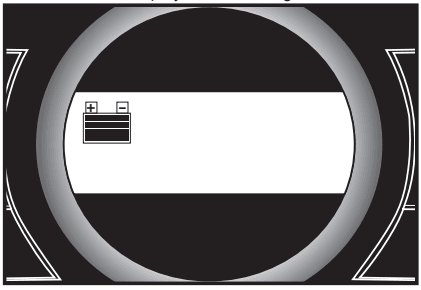 The bars on the battery icon represent the capacity level of the unit’s internal battery. After 10 seconds, the backlight will shut off and the LCD screen will display the following to indicate that the unit is charging:
The bars on the battery icon represent the capacity level of the unit’s internal battery. After 10 seconds, the backlight will shut off and the LCD screen will display the following to indicate that the unit is charging: